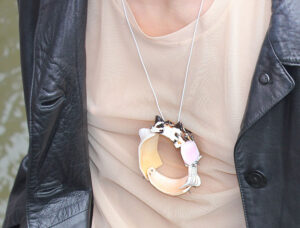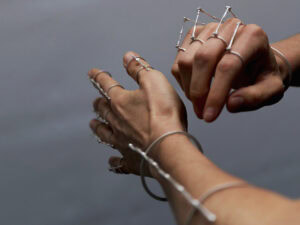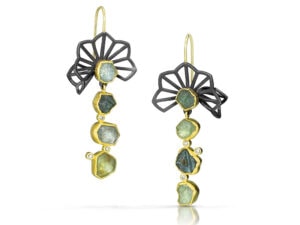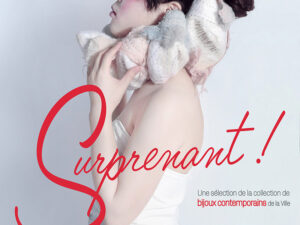
Missy Graff: Please tell me about your background. How did you become interested in making jewelry?
Gabrielle Desmarais: When I first began college, I studied administration while making fashion jewelry for small shops in town. It took some time to realize that jewelry making was an option for me. After giving birth to my first child, I decided to go back to school to complete the jewelry program at the Montreal Jewellery School.
Anne-Marie Rébillard: I felt the need to learn how to work with my hands after I tried a different program of study where I was unsatisfied. I applied to the École de joaillerie de Québec, and I knew quickly after I started that I had found the training I was looking for. I realized that I could express myself through jewelry. For me, jewelery was slowly becoming an artistic medium, just as painting or sculpture can be.
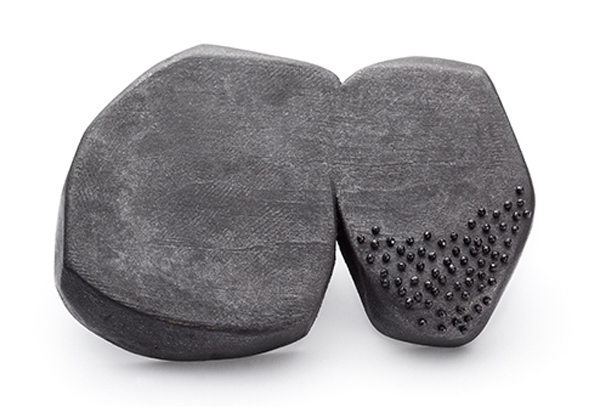
Gabrielle Desmarais: I graduated in 2010, and my work has evolved into something very different over the past three years. In school, I always had a very strong interest in contemporary jewelry. However, my work mainly focused on metalsmithing techniques. My main material was always sterling silver. I now work with a wide range of materials, such as wood, textiles, pearls, stones, and occasionally sterling silver. I find my work to be a lot more personal and authentic now, and I believe this will continue in the years to come.
Anne-Marie Rébillard: My training was very technical and traditional. Since my graduation, I have attended numerous workshops in order to push the boundaries of my creative practice. It was after my participation in creative workshops led by Noel Guyomarc’h (Le Labo) that I allowed myself to freely explore different materials and concepts within a practice that focused on my personal approach. Today, my vision of a piece of jewelry is very different from the vision I had when I first finished school. I now feel much closer to the artist’s world than the world of craft.
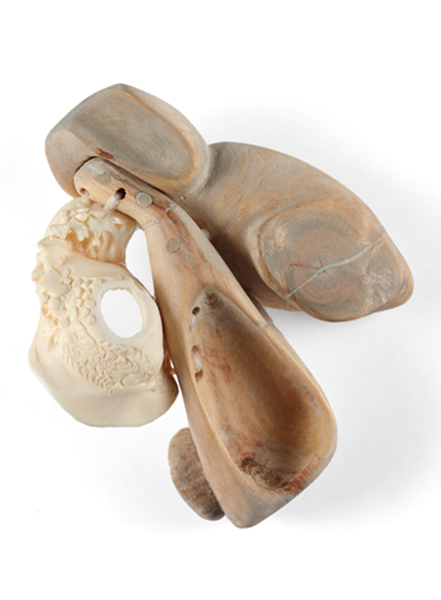
Gabrielle Desmarais: I am a true admirer of Iris Bodemer’s work. Her compositions, choice of materials, and her uncensored creative mind are always an inspiration for my own creative process. I am also inspired by the work of Ruddt Peters. I love the way he reinvents himself from one exhibition to another. He defies all expectations and always surprises me with his new concepts and work.
Anne-Marie Rébillard: I do not have a particular model. I try to stay abreast of what is happening on the stage of contemporary jewelry, especially in Europe. During the creative workshops led by Noel Guyomarc’h (Le Labo), I had the opportunity to meet outstanding artists whose work I admire: Andrea Wagner, Despo Sophocleous, and Luzia Vogt. It was as if I wanted to absorb everything—each of their comments and criticisms were very precious to me.
Recently, I attended a workshop led by Andrea Wagner and Ela Bauer at the École de Joaillerie de Montréal. This was a very great experience. I had the chance to discuss my artistic statement, and all the doubts that come with it, in the light of their rich and sensitive views. Finally, I cannot forget my “old master” from school, Michel-Alain Forgues. Although my work has changed a lot since I was in his program, he remains an important influence for me and my career. He was the very first person who gave me the desire and the confidence to dedicate myself to my work.
Please explain the concept for Ce qui n’est pas là. What does it mean in English?
Gabrielle Desmarais: Ce qui n’est pas là means “What is not there.” This title means a lot to us because of its different possible interpretations. What is not there in the show, or in a particular piece, becomes very personal to the viewer or maker. We wanted a short title that would say everything. We did not want to strongly propose the vision of our work through the title. Instead, we wanted each person to be able to create his or her own story to link with the pieces.
Anne-Marie Rébillard: Ce qui n’est pas là means “What is not there.” My recent work Trace is about the cultural marks humans leave on their habitat. For me, Ce qui n’est pas là refers to the stories we can construct in our minds at the sight of a trace, mark, or found object. It invites viewers to look beyond what they see at first glance, beyond the material used, and beyond their preconceived ideas of what a jewel is. In a way, it’s an evocation of another dimension from which everyone has the freedom to conceive their own experience of reality.
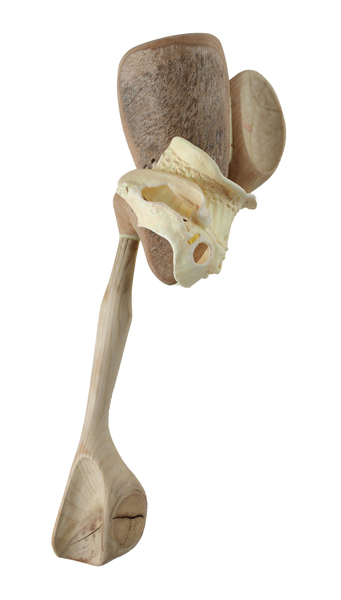
Did you choose to exhibit together, or was that Noel’s choice?
Gabrielle Desmarais: Anne-Marie and I have known and appreciated each other’s work for a long time now. However, it was Noel’s great idea to reunite us to present this exhibition.
Can you explain the significance of wood, and why it was chosen as the primary material for this exhibition?
Gabrielle Desmarais: Anne-Marie and I live in different cities, and although we knew the title of the exhibition, we did not know what the other’s work would look like or what the materials would be. It was a great coincidence that we both worked with the same material. That just shows how much we were meant to be! Personally, I love wood because it gives me the possibility to sculpt and paint the material in a very visceral and spontaneous way. The pine and cedar wood I choose to work with are both very light. This gives me the opportunity to create fairly big pieces that are still wearable. Wood is a very sensuous material, and it brings a twist of poetry to my pieces of jewelry.
Anne-Marie Rébillard: It was a coincidence that Gabriel and I used wood in our recent series. I began exploring plastic last year. This material stimulated my creative process a lot, but I felt it was not enough to express what I had in my mind. It needed something else. I thought a lot about my ideas of marks, traces, waste, etc. As I walked along the banks of the St. Lawrence River, I watched the driftwood that was rejected by the sea. I felt something really poetic about the idea of associating wood to plastic, which is rejected by humans. It was important to me that the wood used in this series was all driftwood, and not just any wood. It was also important to work with it and transform it, as I did with plastic, to leave my mark.
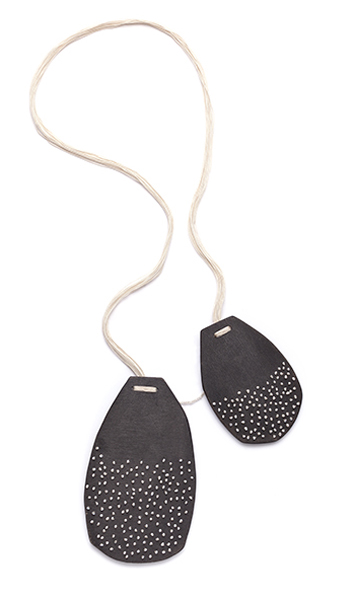
Can you please discuss your process? Do you sketch or make models before working on the final piece? Do you feel that the physical process of making the work changes the outcome?
Gabrielle Desmarais: I always draw the pieces I have in mind with the understanding that the final piece will never end up exactly like my drawings. When I begin a new piece, I define the main lines of my ideas, but after a certain point, I have to let go and allow the piece to decide for itself. From that moment on, I feel as though all I have to do is go with the flow and allow the work to reveal itself. Too often, I have passed by an awesome idea just because I wanted the piece to look like my drawing. My latest work defies this old pattern, and the outcome is much more personal and surprising.
Anne-Marie Rébillard: Drawing is essential to my process, but not in the manner of a sketch or a work plan. When I draw, I do not think about jewelery. I simply draw. Similarly, I do not try to reproduce my drawings into jewelry. For me, drawing is a quick and easy way to explore my world and a way to let go of the final outcome. Of course, when I look at my drawings while I work, I can see the similarities in my jewelry. In some ways, my world stays the same regardless of the medium.
In my studio, I usually experiment a lot with materials without thinking. Some explorations turn out to be more interesting than others, so I keep them. I have a small collection of handmade fragments on my bench. I try to combine these fragments together, using different assembly techniques. I always work on several pieces at the same time. What often happens is that I temporarily assemble one piece, confident that I have found the perfect mix, and then take apart everything the next day because I have made another fragment that works even better. In my work, there are my ideas and my will, but there is also what the material has to offer. It is important for me to stay in tune with the material, to give it enough space to express itself, and to build the piece of work quietly with no preconception of the final product.
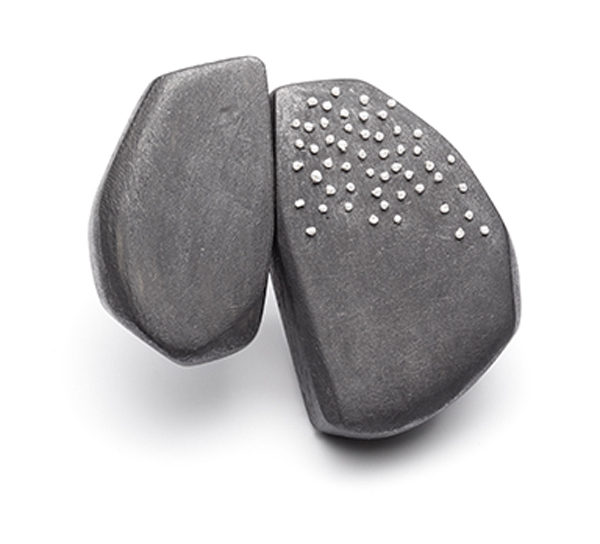
Gabrielle Desmarais: I would like viewers to feel like there is a special story hidden inside every piece. I hope that they can relate to the work in a very intimate way, holding onto these pieces of jewelry like treasure.
When Anne-Marie and I installed the exhibition, we were stunned to see our pieces united in perfect harmony. I believe we propose a beautiful and poetic path for contemporary jewelry, and I hope to continue promoting the field in Montreal and abroad.
Anne-Marie Rébillard: I do not want to tell the viewers what they should experience. I want viewers to feel free to make up their own story. When people tell me how they feel in front of my work (or while wearing it), I am always amazed and touched by their interpretations, which I would not have thought of, simply because we all watch the world through the filter of our own experience.
Please describe the most interesting exhibition you have seen lately.

Gabrielle Desmarais: I was in Barcelona for a few days while exhibiting in JOYA Contemporary Jewellery Fair. While I was there, I saw a solo exhibition by Mexican artist Jorge Manilla. I really loved his latest work in which he used burned wood, leather, and sterling silver. The strong collection of pieces was displayed on skulls. The walls of the exhibition space were black in a very dark room where only the pieces were lit. It was amazing.
Anne-Marie Rébillard: While I was in Paris this past spring, I went to see the exhibition of Ronan and Erwan Bouroullec Momentané at the Musée des Arts décoratifs. I was particularly captivated by the abundance and variety of drawings presented, especially the way these two designers represent what looks like textures. I felt that the drawings were works of art in themselves. They were suspended moments of the artist’s universe, very free and spontaneous.
What are you reading right now?
Gabrielle Desmarais: The last few weeks have been the busiest of all time. Reading has been on my “to-do” list for too long. Between my kids and putting together great exhibitions, reading is not option at this moment. I hope to read something soon. I love reading.
Anne-Marie Rébillard: Right now, nothing to do directly with my work: La force de l’âge (The Prime of Life) by Simone de Beauvoir. The novel that accompanied me during the realization of my last body of work was L’insoutenable légèreté de l’être (The Unbearable Lightness of Being) by Milan Kundera.
Thank you.


